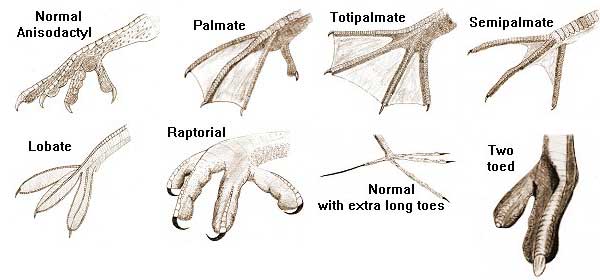Bird Legs & Feet
Although the construction of the wing and the ability to fly are often what capture our attention with bird anatomy, the legs and feet of birds are also critical to their lifestyle and success as predators and as prey species. Even in birds whose dominant means of locomotion is flight, there are stresses involved in take-off and landing. Many predators kill their prey with their feet and carry it off to their nests. Ratites (ostriches, emus, rheas) are large birds that run rather than fly to escape their predators. All of these birds require relatively heavy and strong leg bones.
Most birds have four toes. The first points backwards in most species. The fifth toe has been lost completely in most birds, although it may remain as a defensive spur in birds like chickens. The foot is a very important appendage for a bird, being the only source of support when standing, walking and running on a variety of surfaces. It also is a means of propulsion in aquatic species, a major weapon in many predatory species and for some birds their equivalent of a hand, functioning to grasp and hold objects the bird wishes to manipulate, mostly during feeding.
The size and shape of the claws and the way the toes are arranged, as well as the length of the toes and the degree of webbing, are all dependent on what a bird uses its feet for and where it lives. Like a bird’s bill or beak its feet reveal a lot about its lifestyle. Many birds (particularly passerine birds) have three toes forwards and one back, while others have two forward and two back.
Aquatic birds like ducks, geese and swans all have medium length toes joined together by a web of skin to make an excellent paddle for rowing themselves through the water. They spread the toes on the back stroke to maximize the push then hold their toes together on the forward stroke in order to reduce resistance.
